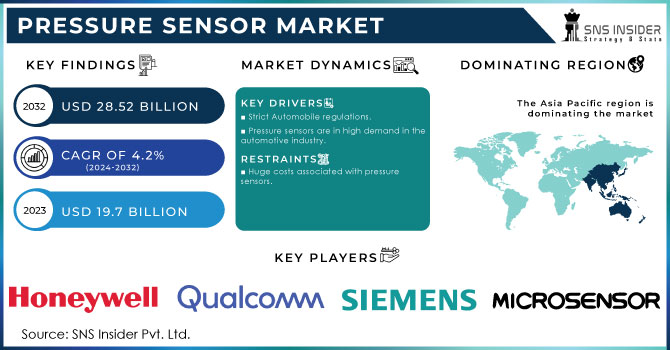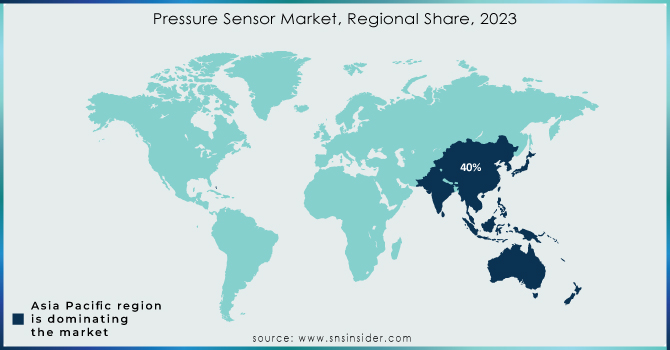Pressure Sensor Market Size:

Get more information on Pressure Sensor Market - Request Sample Report
The Pressure Sensor Market Size was valued at USD 19.7 billion in 2023 and is expected to reach USD 28.52 billion by 2032 and grow at a CAGR of 4.2% over the forecast period 2024-2032.
The pressure sensor is a device that senses pressure and converts it into an electrical signal where the value depends on the pressure applied. Receives, evaluates, and transmits information, which helps analyze device performance. It uses IC fabrication technology made from silicon wafers. It monitors and regulates pressure, usually gases, and liquids.
Pressure Sensor Market Dynamics:
KEY DRIVERS:
-
Strict Automobile regulations.
-
Pressure sensors are in high demand in the automotive industry.
RESTRAINTS:
-
Huge costs associated with pressure sensors.
OPPORTUNITIES:
-
Expansion of the consumer electronics industry.
-
End-user industries are increasingly adopting the Internet of Things (IoT).
CHALLENGES:
-
Demand from the oil and gas industry has decreased due to the COVID-19 pandemic.
-
Significant regulatory barriers.
IMPACT OF COVID-19:
Due to the outbreak of covid 19 in global industries, there are many factors that affect the need for pressure sensors. The marketing process is facing challenges at the moment. The closure of the facilities limits the production process of the market. In particular, the Asian Pacific region when faced with a lot of difficulties performing market functions during this epidemic. In the past, market demand was slowing due to demand from the automotive and smartphone industry. However, with the outbreak of the disease, the prevalence in these areas is low. In the coming years, the market is gaining momentum in many regions. The need for pressure sensors will gradually increase in the coming years. Also, manufacturing activities are experiencing a sudden increase due to the small spread of disease. In the forecast period, demand from key end users will keep the growth of the pressure sensor market.
Pressure Sensor Market Segment Overview:
Based on Product, the pressure sensor market is segmented into Absolute, Differential, Vacuum, Gauge, and Sealed Pressure Sensors.
The market for the differential pressure sensor segment is expected to grow at a very high CAGR from 2024 to 2031. Growth may be due to their widespread use in the industrial area. In industrial processes, differential pressure sensors are included as key components of multiple devices to measure the flow of liquids and gases due to pressure differences across all of these. They are also used to measure pressure in air, acids, foundations, pressurized gases, water, steam, pressure drop across all oil filters or air filters, liquid levels, and flow rates. In addition, differential pressure sensors may be retrofitted and mounted on the vessels.
Based on Technology, the pressure sensor market is segmented into Capacitive, Piezoresistive, Electromagnetic, Optical, Resonant Solid-state, and Others.
The optical technology segment is expected to grow at a very high CAGR during the forecast period. Growth may be due to the increased use of pressure sensors based on visual acuity in harsh environments. These sensors are small in size, flexible, and are made using non-toxic materials. They are able to withstand magnetic disturbances and work well on systems where other pressure sensors fail due to these disturbances. These pressure sensors work best when there are chemicals or explosive substances. Because of this, they are very suitable for medical and oil and gas use.
Based on Industrial Vertical, the pressure sensor market is segmented into Automotive, Industrial, Aviation, Marine, Consumer Electronics, Medical, Utilities, Oil & Gas, and Others.
Consumer electronics is expected to grow at the fastest rate. The rising demand for pressure sensors in smartphones, wearables, and tablets can be attributed to their various advantages such as small size, low cost, and high power efficiency. Because of advancements in MEMS technology, these sensors can be even smaller and integrated into a variety of consumer electronic devices. Pressure sensors, in addition to the devices mentioned above, are in high demand from gaming and navigation applications, as well as home appliances.
Pressure Sensor Market Regional Analysis:
The Asia Pacific regional market dominated the pressure sensor market and accounted for more than 40% of the global revenue share. Partial growth can be attributed to the mass production of electronic components and the growth of investment in R&D. The growing demand for consumer electronics such as tablets, apparel, and smartphones drive the demand for pressure sensors in this region. India and China are major contributors to the regional pressure sensor market. China is a mature market and has strong business opportunities. During the forecast period, North America is expected to be the fastest-growing regional market. The North American regional market is expected to witness growth, due to the huge demand for pressure sensors in TPMS and EGR applications in the automotive sector. The presence of key players in the region is also one of the major factors driving market growth. At the same time, the growing demand for pressure sensors in industries such as oil and gas, petrochemical, and medical is also accelerating market growth in the region.

Get Customized Report as per your Business Requirement - Request For Customized Report
KEY PLAYERS:
The key players in the Pressure sensor market are Honeywell International, Qualcomm Technologies, Texas Instruments, NXP Semiconductor, ABB Ltd, Siemens Ag, Sensata Technologies, TE Connectivity, Micro Sensor, Quartzdyne, Inc, Emerson Electric, Amphenol, BD Sensors GmbH & Other Players.
| Report Attributes | Details |
|---|---|
| Market Size in 2023 | US$ 19.7 Billion |
| Market Size by 2032 | US$ 28.52 Billion |
| CAGR | CAGR of 4.2% From 2024 to 2032 |
| Base Year | 2023 |
| Forecast Period | 2024-2032 |
| Historical Data | 2020-2022 |
| Report Scope & Coverage | Market Size, Segments Analysis, Competitive Landscape, Regional Analysis, DROC & SWOT Analysis, Forecast Outlook |
| Key Segments | • By Sensor Type (Wired Sensors, Wireless Sensors) • By Product (Absolute Pressure Sensors, Differential Pressure Sensors, Vacuum Pressure Sensors, Gauge Pressure Sensors, Sealed Pressure Sensors) • By Technology (Capacitive, Piezoresistive, Electromagnetic, Optical, Resonant Solid-State, Others) • By Functions (Altitude Sensing, Depth Sensing, Pressure Sensing, Flow Sensing, Temperature Sensing) • By Industry Vertical (Automotive, Industrial, Aviation, Marine, Consumer Electronics, Medical, Utilities, Oil & Gas, Others) • By End Use (Automotive On-Vehicle, HVAC Systems, Testing & Measurement Equipment, Medical Devices, Process Control Solutions, Others) |
| Regional Analysis/Coverage | North America (USA, Canada, Mexico), Europe (Germany, UK, France, Italy, Spain, Netherlands, Rest of Europe), Asia-Pacific (Japan, South Korea, China, India, Australia, Rest of Asia-Pacific), The Middle East & Africa (Israel, UAE, South Africa, Rest of Middle East & Africa), Latin America (Brazil, Argentina, Rest of Latin America) |
| Company Profiles | Honeywell International, Qualcomm Technologies, Texas Instruments, NXP Semiconductor, ABB Ltd, Siemens Ag, Sensata Technologies, TE Connectivity, Micro Sensor, Quartzdyne, Inc, Emerson Electric, Amphenol, BD Sensors GmbH and other key players. |
| Key Drivers | • Strict Automobile regulations. • Pressure sensors are in high demand in the automotive industry. |
| Restraints | • Huge cost associated with pressure sensors. |

